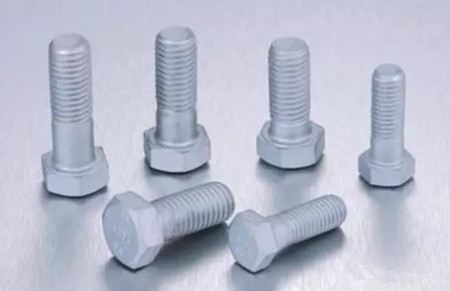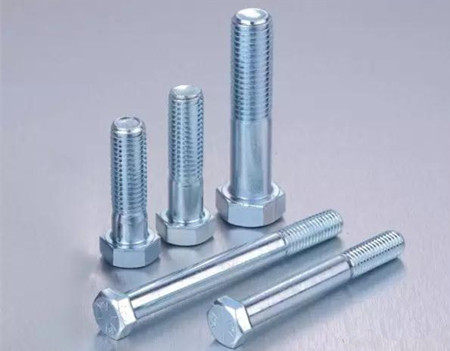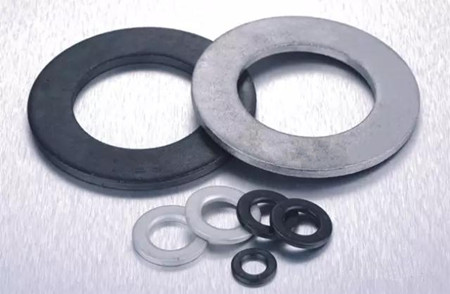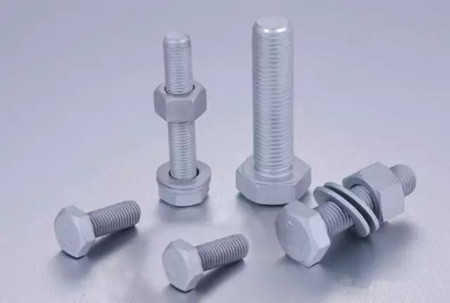The surface treatment of fasteners has many surface treatment methods and processing techniques depending on the requirements of the products. According to the surface treatment method can be divided into many, such as painting, electroplating, electroless plating, vacuum coating, immersion plating, anodizing, blasting hardening, coating, vapor deposition, carburizing, nitriding, surface quenching, etc.; More and more advanced, there are many ways, physical, chemical, electrical, mechanical, metallurgical and so on. Here are a few common surface treatment methods:
1, hot-dip galvanizing
This was accomplished by immersing the carbon steel component in a bath of molten zinc at a temperature of about 510 °C. The result is that the iron-zinc alloy on the surface of the steel piece gradually becomes passivated zinc on the outer surface of the product. However, due to the high temperature in the hot plating, the steel is prone to adverse effects of high temperature annealing.

2, plating
The electroplated member is immersed in an aqueous solution containing the deposited metal compound, and an electric current is passed through the plating solution to cause the plating metal to be deposited and deposited on the member. Generally, plating is performed by galvanizing, copper, nickel, chromium, copper-nickel alloy, etc., and blackening, phosphating, and the like are sometimes included. Hydrogen embrittlement is easy to occur in electroplating, which has a great influence on the mechanical strength of the workpiece.

3, mechanical plating
Mechanical plating is the mixing of an activator, a metal powder, an impact medium (glass microbeads) and a certain amount of water into a slurry, which is placed in a drum together with the workpiece, by the mechanical energy generated by the rotation of the drum, in the activator and the impact medium. (glass microbeads) The process of mechanically colliding, the process of gradually forming a zinc coating on the surface of the iron base at normal temperature.

4, Dacromet ( zinc chrome film )

Zinc-chromium film (Dacro) coating process is a new surface treatment technology, also known as Dacromet, Daklo, Dak rust, zinc-chromium film (Dacro), Dakman and so on. It has been widely used in many fields such as automobile industry, civil engineering, electric power, chemical industry, marine engineering, household appliances, railways, highways, bridges, subways, tunnels, shipbuilding, military industry and so on. With the gradual promotion of this technology, China has begun to use it in automobile, electric power, anchor chain, highway, ocean engineering, etc., and has obtained extremely high evaluation. Zinc-chromium film (Dacro) is a water-based treatment liquid. The metal parts can be dip-coated, sprayed or brushed, and then sent to a furnace for curing. The curing temperature is about 300 °C. Baking to one hour to form a zinc-chromium film (Dacro). When the chromium is solidified, the moisture in the coating film, organic matter (cellulose) and other volatiles are volatilized while relying on the zinc-chromium film. The oxidizing property of the high-valent chromium salt in the mother liquor causes the elemental zinc sheet and the aluminum sheet slurry having a large negative electrode potential to react with the iron matrix to form an inorganic coating of the chromium salt compound of Fe, Zn and Al. Since the film layer is obtained directly after the substrate, the anti-corrosion layer is extremely dense (the anti-corrosion layer obtained by the galvanizing or zinc immersion method cannot be compared with it). The coating forms a myriad of original conditions in a corrosive environment. The battery, that is, the Al and Zn salts with negative potential are etched first, until they are consumed, it is possible to corrode to the substrate itself.
Zinc-chromium film (Dacro) coating characteristics: Zinc-chromium film (Dacro) coating consists of independent zinc sheets and chromic acid polymer units that are overlapped. The chromic acid polymer layer in the zinc-chromium film (Dacro) coating does not contain crystal water, so the corrosion resistance at high temperatures also shows excellent quality. The curing temperature of the zinc-chromium film (Dacro) anti-corrosion film is about 300 ° C, so even if the workpiece is exposed to high temperature for a long time, the appearance will not change color, and the heat corrosion resistance is excellent. Hydrogen embrittlement is a drawback that cannot be completely overcome by traditional galvanizing processes. Due to the process characteristics, the zinc-chromium film (Dacro) does not undergo any acid treatment during the treatment, and there is no hydrogen permeation problem during electroplating. In addition, the coating is cured at a high temperature, so zinc chromium is ensured in the process. The film (Dacro) coating does not have hydrogen embrittlement. This allows it to be applied to the anti-corrosion treatment of high-strength parts with high tensile strength requirements. As a green electroplating process, the zinc-chromium film (Dacro) process adopts a closed-circuit cycle. In the pre-treatment: the removed oil and dust are collected and processed by special equipment; when coating and curing, there is no traditional plating. The problem of sewage from acid, alkali, and heavy metals such as chromium produced during the process produces only water vapor evaporated from the coating, which is determined to contain no harmful substances controlled by the state. The zinc-chromium film (Dacro) is matt silver grey and can be recoated on top. This meets the coating requirements for workpieces that require high quality appearance.
There is always a gap between theory and practice. In theory, its corrosion resistance is better than that of electro-galvanizing. However, in practical applications, some fasteners were found to have pitting corrosion soon after use, and the process of making the workpiece was carefully analyzed. Obvious obvious deficiencies were found. After statistical analysis of a large number of problematic workpieces, it was found that most of the locations where rust spots appeared were at the sharp corners of the workpiece, but not all sharp corners would have rust spots. The main problem to solve is the integrity of the coating. The strength of the zinc-chromium film (Dacro) coating itself is not high, the hardness is only 1H, in order to maintain the integrity of the coating, one can change the formulation of the coating, increase the plasticity, and the other method is in the zinc-chromium film. A protective coating is applied over the (Dacro) coating to maintain the integrity of the coating during transport.
After screening by everyone, we use a water-based anti-corrosion sealer, which has the advantages of low price and low cost after use. The mother liquor of the water-based anti-corrosion sealing agent can be formulated into a working fluid in a ratio of one to four, and the coating liquid per kilogram can be coated with an area of ​​about ten square meters, and can improve the overall corrosion resistance of the coating. Another optional zinc-chromium film (Dacro) coating reinforced coating is Teflon, which has strong anti-corrosion at the sharp corners and can be better used to complete the work.
Newstar Hardware Co., Ltd is committed to different kinds of tools kit, Hand Tool kit, power Tool Kit , garden tool kit, for various using condition in life. Power tool combo kits is one of our hot selling items. Power tools combine with Hand Tools, power tools combine with Garden Tools, or other kinds of tools per your needs. Power tools quality good, battery quality ensure. Choose high quality power tools bundles, choose us.
Power Tool Combo Kits,Power Tool Combo Sets,Power Tool Bundles,Power Tool Combo
SUZHOU NEWSTAR HARDWARE CO.,LTD. , https://www.hardwarenewstar.com